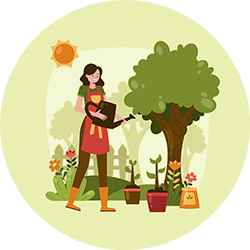The Science Behind Seed Germination (Made Simple)

Seed germination may seem like magic, but it follows a fascinating and predictable process. Understanding what happens inside a seed helps you grow stronger, healthier plants right from the start. Whether you’re starting veggies, herbs, or flowers, knowing the science behind sprouting gives you a valuable edge in the garden.
What is seed germination?
Seed germination is the process by which a seed develops into a new plant. Inside every viable seed is a tiny plant embryo, surrounded by a food supply and protected by a hard outer coat. When the right conditions are met, the seed comes to life, using its stored energy to begin growing.
This process marks the start of a plant’s life cycle and is triggered by environmental cues like water and temperature. Understanding how germination works can help you improve your success when starting seeds at home, whether you are growing vegetables, herbs, or flowers.
The stages of germination
Imbibition
The first step in germination is imbibition, when the seed absorbs water and begins to swell. Water softens the seed coat and activates enzymes inside the seed. This stage prepares the seed for the energy-driven work of growing.
Activation
Once hydrated, the seed’s internal enzymes begin converting stored starches and proteins into usable energy. This biochemical activity fuels the development of the embryo. Although this step is not visible from the outside, it is essential for growth to begin.
Radicle emergence
The radicle is the first root, and it is typically the first part of the seedling to break through the seed coat. It anchors the plant and begins to take in water and nutrients from the surrounding soil. This moment is usually considered the official start of germination.
Shoot growth
After the root takes hold, the shoot begins to push upward toward the light. This shoot contains the stem and the seed leaves, also known as cotyledons. Once the seedling emerges above the soil surface, it begins to photosynthesize and continues growing as a young plant.
What seeds need to germinate
Water
Moisture is the first and most important factor in germination. Water triggers the enzymes inside the seed and allows the seed coat to soften and expand. Seeds should be kept consistently moist but not soaked.
Oxygen
Seeds need oxygen for cellular respiration, which provides the energy they need to grow. If the soil is compacted or waterlogged, oxygen can be limited and germination may fail. Good soil structure helps ensure that roots and shoots develop properly.
Temperature
Each type of seed has a preferred temperature range for germination. Warm-season crops like tomatoes need higher temperatures, while cool-season crops like lettuce prefer cooler soil. Using a heat mat indoors can help maintain optimal conditions.
Light or darkness
Some seeds require light to germinate, while others need to be buried in darkness. Lettuce and snapdragons germinate best on the soil surface, while beans and squash prefer to be covered. Always check seed packets or reliable sources for each variety’s preference.
Factors that affect germination success
Seed quality plays a major role in germination. Old seeds or those stored in poor conditions may lose viability. Always buy from reputable sources and check expiration dates.
Soil condition matters too. Seeds need a light, well-draining medium to sprout. Overwatering, poor drainage, or planting too deeply can all cause seeds to rot before they have a chance to grow.
Temperature swings, low humidity, or incorrect spacing can also reduce success. Starting with a consistent, stable environment gives your seeds the best chance to sprout and thrive.
Common seed-starting methods
Direct sowing involves planting seeds straight into the ground or a container outdoors. This works well for fast-growing or cold-hardy plants. It is simple and requires no special equipment.
Indoor seed trays allow you to control light, moisture, and temperature more precisely. Many gardeners use trays with cell inserts and humidity domes to start seeds early in the season.
The paper towel method is a great way to observe germination up close. Seeds are placed between moist paper towels and sealed in a plastic bag until they sprout. This method helps confirm viability before planting.
Signs germination is or isn’t happening
When germination is going well, you’ll see a tiny white root emerging within a few days to two weeks, depending on the seed. A healthy sprout will soon follow with a stem and seed leaves.
If the seed stays soft and starts to smell, it may have rotted due to too much moisture or poor airflow. Mold on the soil surface or no sprouting after two weeks are also signs something is off.
Check your setup and adjust water, temperature, or planting depth as needed. Some seeds take longer than others, so patience is also part of the process.
How to improve germination rates
Some seeds benefit from pre-soaking in warm water for a few hours before planting. This softens tough seed coats and speeds up imbibition. Scarification, or gently nicking the seed coat with a file, can also help certain seeds germinate faster.
Keeping a stable environment is key. Use humidity domes to retain moisture and heat mats to provide gentle warmth under seed trays. Grow lights can give seedlings the light they need once they emerge.
Label your seeds and track their progress so you can learn what works best in your setup. Over time, you’ll gain a better understanding of how to consistently start seeds successfully.
Conclusion
Germination is the foundation of every plant’s life, and with the right knowledge, you can guide seeds from dormancy to vibrant growth. By learning what seeds need and how to support each stage of their development, you’ll improve your success and gain confidence as a grower. A little science goes a long way toward growing with intention and joy.
